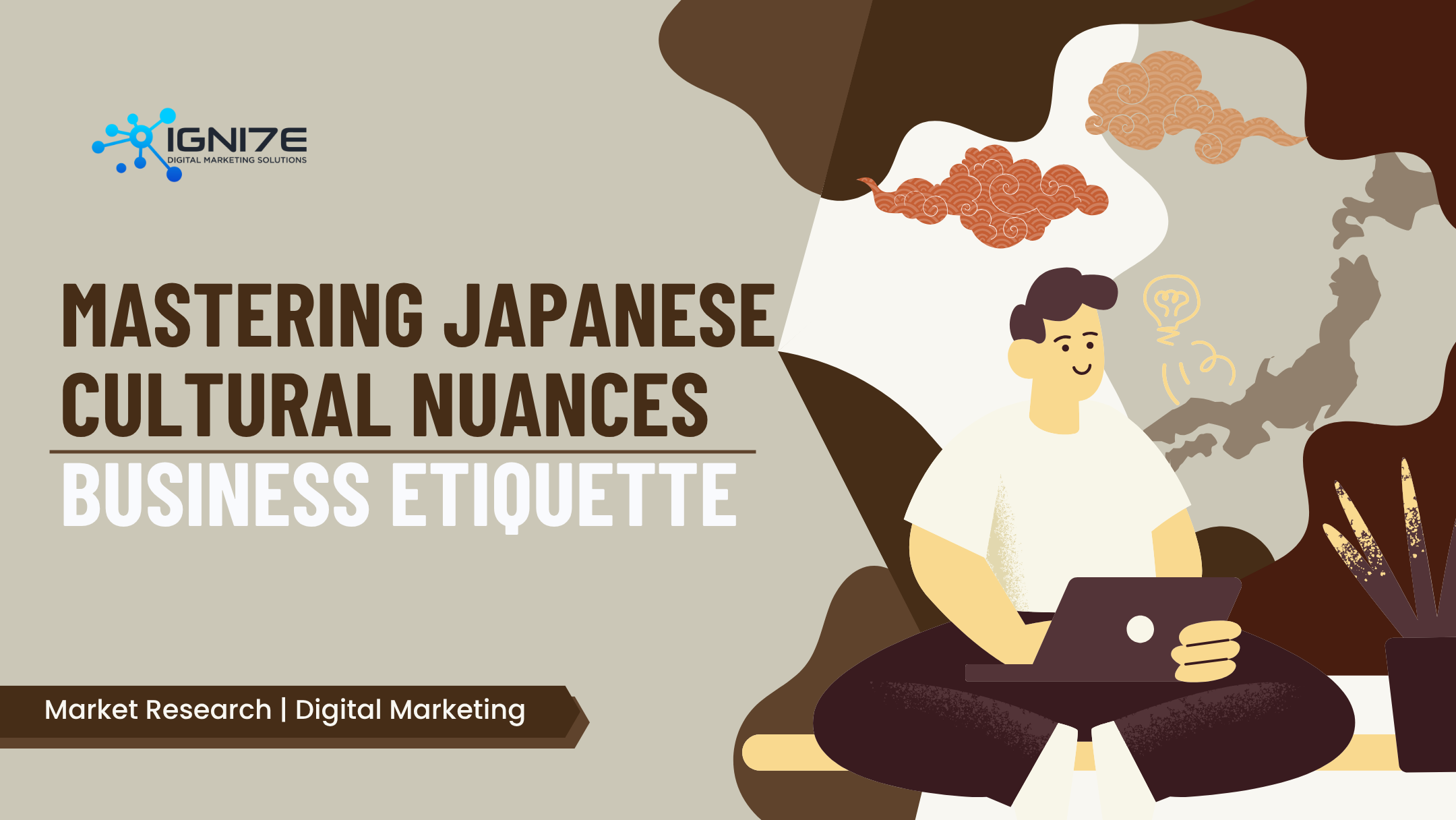Points essentiels à prendre en compte lors de la réalisation d'une étude de marché au Japon

Avant d'entrer sur le marché japonais, la réalisation d'études de marché approfondies est la première étape la plus importante. De nombreuses entreprises étrangères se précipitent, convaincues qu'une simple traduction de leur produit ou de leur site Web suffira, pour constater que les différences culturelles, les attentes des consommateurs et la dynamique concurrentielle compromettent leur succès.
L'état de préparation réel ne se limite pas à une adaptation linguistique ; il s'agit de vérifier si votre produit répond réellement aux besoins et aux préférences des clients japonais. Au cœur de ce processus se trouve l'étude de la concurrence, qui consiste à comprendre qui dessert déjà le marché, comment ils se positionnent et à identifier les opportunités de différenciation. Sans cette base, même les plus grandes marques mondiales risquent de ne pas s'aligner au Japon.
Pourquoi la recherche concurrentielle est importante au Japon
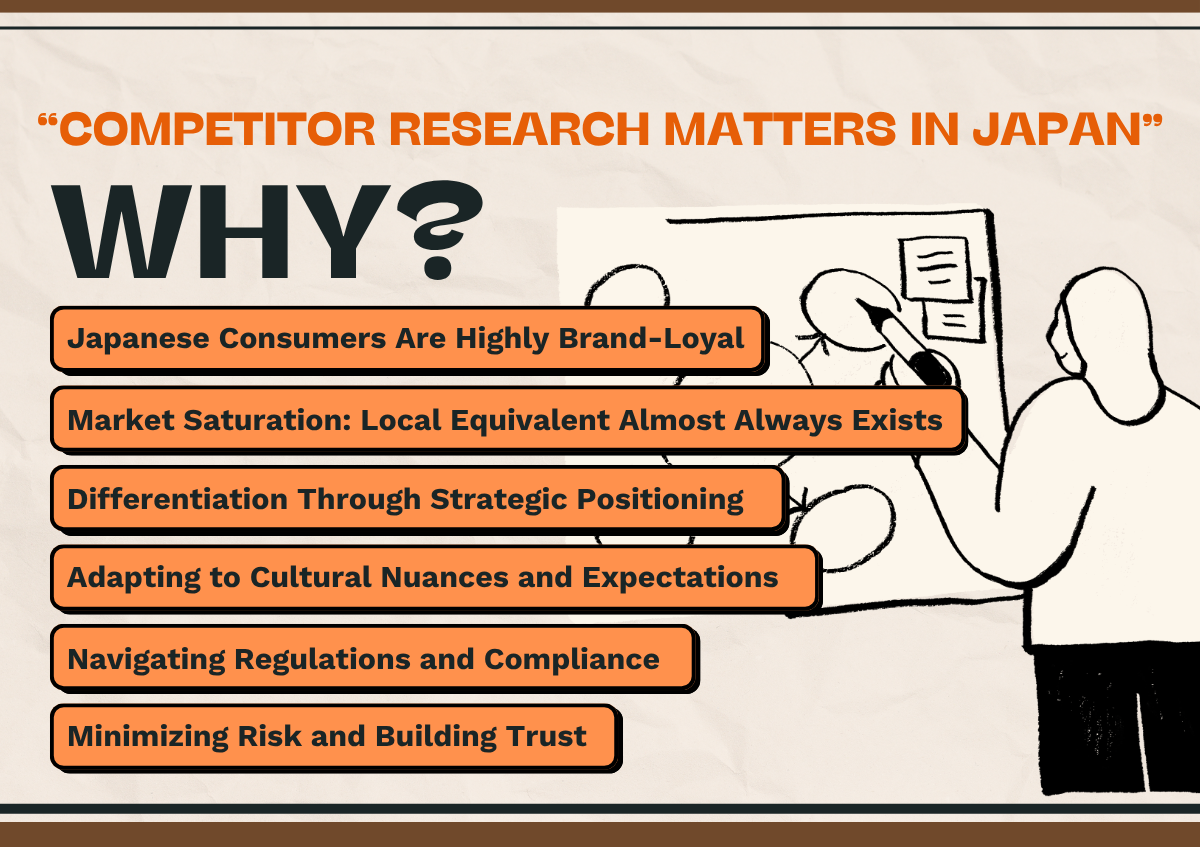
Entrer sur le marché japonais sans avoir étudié la concurrence, c'est comme se lancer dans un jeu d'échecs sans en comprendre clairement les règles. Contrairement aux États-Unis, où les nouveaux produits peuvent souvent gagner du terrain rapidement, le marché japonais est saturé de marques nationales bien établies qui ont établi une relation de confiance de longue date avec les consommateurs. L'analyse de la concurrence est donc non seulement utile, mais essentielle.
1. Les consommateurs japonais sont très fidèles à la marque
Les acheteurs japonais ont tendance à s'en tenir à des marques qu'ils connaissent et auxquelles ils ont confiance, même si les alternatives semblent moins chères ou plus tendances. Cela signifie que les nouveaux entrants sont confrontés à un « coût de changement » plus élevé que sur des marchés tels que les États-Unis. Par exemple, une nouvelle marque de suppléments aux États-Unis pourrait rapidement bouleverser le marché grâce à des prix agressifs et à des campagnes d'influence, alors qu'au Japon, les consommateurs sont beaucoup plus susceptibles de rester fidèles aux alternatives locales familières.
2. Saturation du marché : un équivalent local existe presque toujours
Le marché japonais est sophistiqué et compétitif, avec de puissants acteurs locaux dans presque toutes les catégories, de l'alimentation et des cosmétiques à la technologie et aux soins de santé. L'étude de la concurrence permet d'identifier les véritables écarts et de déterminer s'il est possible de se différencier. Sans cette étape, entreprises internationales risquent de lancer « juste un produit comme les autres » dans un espace déjà dominé par des acteurs historiques de confiance.
3. Différenciation grâce à un positionnement stratégique
Étudier les caractéristiques des produits, l'image de marque et le service client révèle à la fois les opportunités et les menaces. En cartographiant les forces et les faiblesses de leurs concurrents, les entreprises peuvent identifier où élaborer une proposition de valeur unique, que ce soit par le biais de l'innovation, de la stratégie de prix ou de l'expérience client.
4. S'adapter aux nuances et aux attentes culturelles
La culture d'entreprise japonaise valorise la hiérarchie, les relations et la qualité. Les concurrents les plus performants répondent déjà à ces attentes. En les analysant, les marques étrangères peuvent apprendre à adapter l'emballage des produits et les communications marketing, et même la prestation de services pour mieux répondre aux attentes des consommateurs japonais.
5. Réglementation et conformité en matière de navigation
Le Japon dispose de lois strictes en matière de protection des consommateurs, telles que la Loi sur la protection des informations personnelles (APPI). L'étude de la concurrence peut révéler la manière dont les marques établies gèrent la conformité, en proposant des points de référence pratiques à suivre pour les nouveaux entrants.
6. Minimiser les risques et renforcer la confiance
En fin de compte, la recherche sur la concurrence au Japon réduit l'incertitude. Il aide les entreprises à anticiper les obstacles potentiels, à éviter des erreurs coûteuses et à développer des stratégies adaptées aux réalités locales. Mieux vous comprenez le paysage concurrentiel, mieux vous êtes en mesure de gagner la confiance des consommateurs japonais, qui peut prendre beaucoup plus de temps que sur de nombreux marchés occidentaux.
Comment l'étude de la concurrence favorise une entrée plus intelligente sur le marché japonais
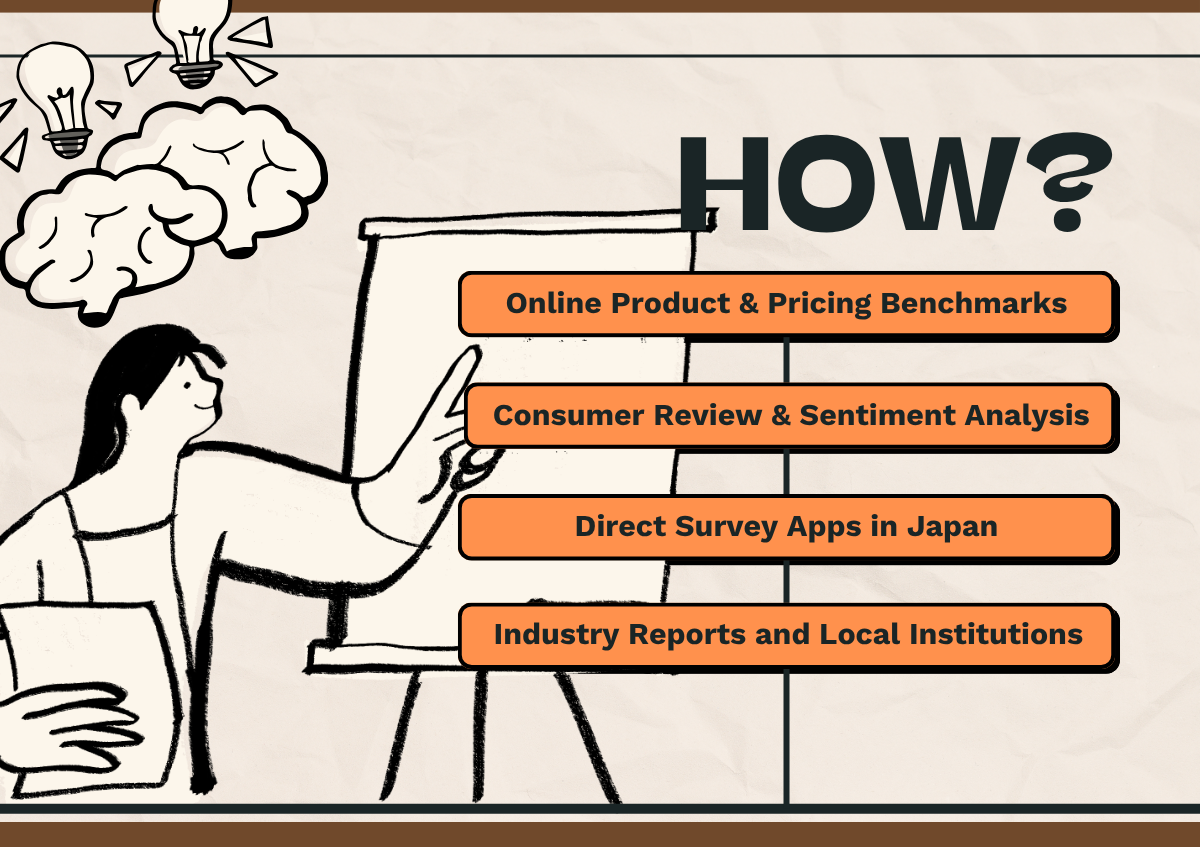
La recherche sur la concurrence au Japon nécessite une combinaison stratégique de plateformes numériques, d'outils d'enquête et de ressources institutionnelles. Vous trouverez ci-dessous les méthodes les plus efficaces et les principales plateformes japonaises sur lesquelles vous concentrer.
Benchmarks de produits et de prix en ligne
Les prix constituent souvent l'une des différences les plus importantes entre les États-Unis et le Japon. Les consommateurs japonais s'attendent à des prix cohérents et transparents, et ils ont tendance à comparer minutieusement les options avant d'effectuer un achat. Pour comprendre le positionnement de vos concurrents, commencez par les plateformes suivantes :
Kakaku.com — Le site de comparaison de prix le plus complet du Japon. Il suit les prix dans différentes catégories, notamment l'électronique, les appareils électroménagers et les cosmétiques. Utile pour surveiller les stratégies de prix des concurrents et les avis des consommateurs.
Rakuten Ichiba — Le géant japonais du commerce électronique. Au-delà de la simple tarification, Rakuten fournit des informations précieuses sur la manière dont les vendeurs locaux emballent les produits, organisent des promotions et développent des programmes de fidélité.
Yahoo ! Shopping au Japon — Une place de marché importante avec des prix compétitifs et des données d'évaluation.
ZOZOTOWN — Le premier centre de mode en ligne du Japon, idéal pour comparer les prix et les tendances des vêtements et accessoires.
Conseil d'action : comparez les prix de votre produit à ceux des trois principaux concurrents sur Kakaku, Rakuten et Amazon Japan afin de déterminer si vous devez vous positionner en tant que marque premium, à parité ou à prix réduit.
Avis des consommateurs et analyse des sentiments
Au Japon, le bouche-à-oreille et la confiance des consommateurs influencent fortement les décisions d'achat. Les avis et les conversations en ligne fournissent une fenêtre sur la façon dont les consommateurs locaux perçoivent vos concurrents.
Rakuten et Yahoo ! Avis sur les achats — Lisez les commentaires détaillés des acheteurs sur la qualité, l'expédition et le service. Les critiques japonaises mettent souvent en évidence des défauts ou des points forts subtils des produits que les critiques occidentales peuvent ignorer.
Social Listening sur Twitter Japan — Twitter (X) est très populaire au Japon et largement utilisé pour les commentaires des consommateurs en temps réel. Le suivi des mentions de marques révèle les discussions sur les sentiments et les tendances.
LINE Open Chat — La plateforme de messagerie #1 du Japon, LINE, héberge également des discussions communautaires. L'observation de la manière dont les produits sont abordés ici vous aide à recueillir des informations authentiques de consommateur à consommateur.
Conseil d'action : suivez les plaintes récurrentes concernant les produits concurrents (par exemple, taille de l'emballage, prix, support après-vente). Elles peuvent révéler des opportunités de différenciation.
Applications de sondage direct au Japon
Contrairement aux États-Unis, où des outils tels que SurveyMonkey ou Qualtrics dominent, le Japon possède des applications de sondage localisées qui encouragent les consommateurs à participer activement en échange de points ou de récompenses. Ces informations sont précieuses pour recueillir des informations directes sur les consommateurs.
Macromill//Questant — le plus grand fournisseur de recherche du Japon, proposant des panels de sondage et un accès à Yahoo ! et des membres de GMO.
Rakuten Insight — S'appuie sur l'écosystème de Rakuten, donnant accès à des millions de consommateurs japonais.
Recherche LINE — Intégré à l'application LINE, il permet des enquêtes rapides avec une large portée.
Panel de recherche sur le Japon — Une option fiable avec une large couverture démographique.
Zozo Research — Axé sur la mode et le style de vie, idéal pour les marques de vêtements ou de beauté.
InfoQ et Honey Q — Des plateformes plus petites qui offrent toujours un accès fiable aux personnes interrogées pour les enquêtes de niche.
Conseil d'action : Réalisez une brève enquête auprès des consommateurs japonais pour évaluer leur degré de reconnaissance à l'égard des produits de vos concurrents, ce qu'ils apprécient chez eux et s'ils envisageraient d'en changer.
Rapports sectoriels et institutions locales
Pour une vision stratégique plus approfondie, complétez les études directes auprès des consommateurs par des rapports sectoriels et des données gouvernementales :
METI (Ministère de l'Économie, du Commerce et de l'Industrie) — Fournit des rapports détaillés sur les tendances du secteur.
E-Stat — Le portail de statistiques officiel du Japon, qui couvre la démographie, le travail et les segments de marché.
Institut de recherche Nomura/Institut de recherche Daiwa — Propose une analyse de marché de haut niveau et des informations prospectives.
Conseil d'action : utilisez les rapports institutionnels pour recouper les résultats des études auprès des consommateurs. Par exemple, si des enquêtes suggèrent un vif intérêt pour les cosmétiques écologiques, les rapports du METI peuvent confirmer s'il s'agit d'une tendance croissante à l'échelle nationale.
Comparaison des études de marché au Japon et aux États-Unis
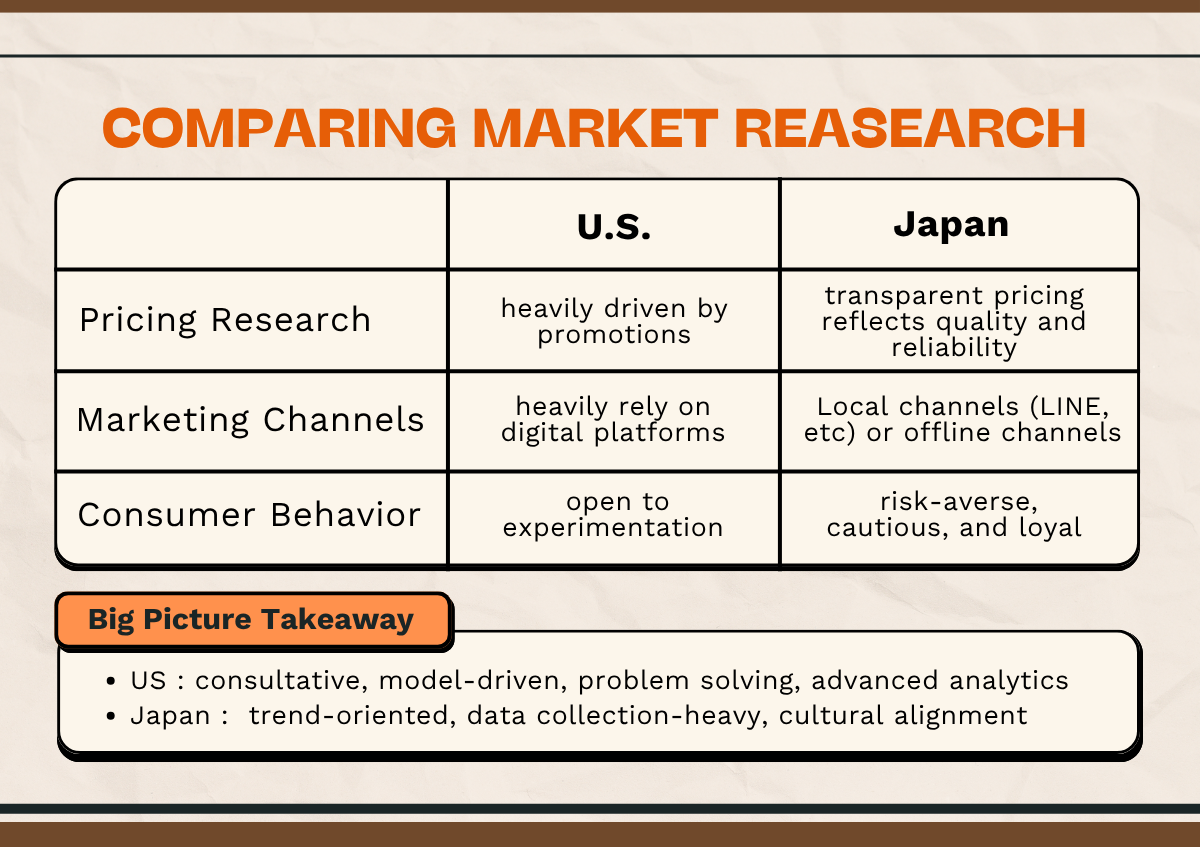
Les entreprises internationales partent souvent du principe que les méthodes d'études de consommation peuvent être transférées directement d'un pays à l'autre. Cependant, le Japon et les États-Unis présentent deux cas très différents. Bien que ces deux économies soient avancées et comptent des consommateurs avertis, la manière dont les études de marché sont menées, interprétées et traitées varie considérablement. Comprendre ces contrastes est crucial pour les entreprises qui envisagent de pénétrer le marché japonais.
Recherche sur les prix
États-Unis:
Aux États-Unis, l'environnement du commerce de détail est très concurrentiel et fortement influencé par les promotions. Les consommateurs sont habitués aux remises constantes, aux soldes saisonnières, aux offres « achetez-en un, obtenez-en un gratuitement » et aux programmes de fidélité. Les marques utilisent régulièrement des stratégies promotionnelles agressives pour acquérir de nouveaux clients, sachant que les consommateurs américains sont généralement à l'aise de changer de marque pour obtenir une meilleure offre. Par exemple, sur le marché des suppléments, les consommateurs américains peuvent être incités à essayer une nouvelle marque si celle-ci propose un code de réduction, la livraison gratuite ou une promotion d'influence.
Aux États-Unis, les études de marché se concentrent souvent sur la modélisation de l'élasticité, afin de comprendre comment les variations de prix affectent la demande. Les entreprises s'appuient sur des analyses de données sophistiquées pour tester différents niveaux de prix et identifier le « point idéal » entre les ventes et la rentabilité. En bref, les études de prix américaines sont conçues autour de l'expérimentation et de campagnes à court terme.
Japon:
Le Japon répond à un ensemble différent d'attentes des consommateurs. Plutôt que de compter sur des remises importantes, les consommateurs japonais préfèrent des prix stables et transparents qui reflètent la qualité et la fiabilité. Bien que des remises existent, elles sont moins agressives et généralement liées à des événements saisonniers, tels que les soldes du Nouvel An. Il est important de noter que des remises fréquentes peuvent être le signe d'une mauvaise qualité ou d'une instabilité financière pour les acheteurs japonais, érodant ainsi la confiance au lieu de la renforcer.
Cette différence culturelle signifie que les études de marché sur les prix au Japon devraient se concentrer moins sur les tests de promotions rapides et davantage sur l'analyse comparative des niveaux de prix quotidiens des concurrents. Des outils tels que Kakaku.com, Rakuten Ichiba et Amazon Japan sont essentiels pour cartographier la manière dont les concurrents établis fixent les prix de leurs produits. Les chercheurs doivent également examiner la perception du rapport prix/valeur, afin de déterminer si les consommateurs japonais pensent que la qualité et l'héritage de la marque justifient le coût.
Implications pour les entreprises étrangères : Aux États-Unis, un nouvel entrant peut rapidement bouleverser le marché grâce à des offres promotionnelles. Au Japon, des remises agressives peuvent avoir l'effet inverse. La recherche devrait plutôt identifier la fourchette de prix fiable pour des produits similaires et se positionner en conséquence.
Canaux de commercialisation
États-Unis:
Aux États-Unis, les stratégies marketing s'appuient largement sur des plateformes numériques telles qu'Instagram, Facebook et YouTube. Ces canaux captent l'attention des consommateurs, en particulier des jeunes. Le marketing d'influence est très efficace, les macro et micro-influenceurs influençant de manière significative les décisions d'achat dans différentes catégories. Le marketing par e-mail reste également un outil puissant pour un engagement direct et personnalisé.
Aux États-Unis, les sociétés de recherche analysent souvent des indicateurs tels que les taux de clics, les ratios d'engagement et les modèles d'attribution sur ces plateformes afin d'affiner les campagnes marketing. Les informations sur les consommateurs sont généralement granulaires et se concentrent sur les préférences individuelles et les profils d'acheteurs segmentés.
Japon:
The Japanese marketing ecosystem looks very different. The dominant app is LINE, which functions not only as a messaging platform but also as a shopping, payment, and loyalty hub. Companies often run official LINE accounts where they post promotions, conduct surveys, and handle customer service interactions. Twitter (X) is also extremely popular in Japan, more so than Instagram, as it is seen as a platform for real-time information and public conversation.
Additionally, Japanese consumers continue to place a high value on in-person brand experiences. Pop-up shops, department store placements, and retail demos are common marketing touchpoints. Offline research methods, such as in-store observation and customer intercept interviews, remain valuable for understanding how consumers interact with products in a physical setting.
Implication for foreign companies: A US brand that invests heavily in Instagram or TikTok ads may find little traction in Japan if it ignores LINE and Twitter. Market research must capture where Japanese consumers actually spend their time, how they interact with brands on these platforms, and which offline channels continue to shape trust.
Consumer Behavior Differences
United States:
The US consumer base is generally open to experimentation. Driven by diversity, competition, and a culture of early adoption, Americans are often willing to try new brands and products, especially if they promise innovation or value. Loyalty exists, but it is fragile; price and novelty can quickly sway consumers to competitors.
Market research in the US reflects this mindset. Studies often focus on individual preferences, A/B testing, and predictive models that highlight how consumers might react to new product launches. Surveys and panels are designed to capture specific customer segments and measure how brand positioning resonates with different demographics.
Japan:
Japanese consumers are almost the opposite in their approach. They tend to be risk-averse, cautious, and loyal to established brands. Once trust is earned, it is enduring, but breaking into that trust cycle is extremely difficult. Peer influence and collective sentiment play a stronger role in this context; if a product gains social proof through reviews, word of mouth, or media coverage, it is far more likely to succeed.
This cultural orientation changes how market research should be conducted. Instead of focusing on niche personas, research must aim to capture group-level preferences and broad cultural trends. Japanese surveys may also yield more neutral or indirect responses due to cultural differences in communication styles, requiring careful interpretation of the data.
Implication for foreign companies: In the US, consumer behavior research should identify early adopters who will quickly spread a new product. In Japan, the emphasis must be on building social proof and credibility, often by studying competitor reviews, loyalty programs, and the collective voice of consumers.
Big Picture Takeaway
In the US, market research is consultative, model-driven, and focused on solving business problems with advanced analytics. It assumes consumers will switch easily if they see value.
In Japan, market research is trend-oriented, data collection-heavy, and focused on cultural alignment. It assumes that consumers are cautious, loyal, and require a deep level of trust before switching.
This contrast highlights why competitor research is so critical in Japan. A brand cannot assume its US strengths: aggressive pricing, flashy influencer campaigns, or novelty alone will translate. Instead, success in Japan depends on understanding competitors’ pricing stability, cultural fit, and trust-building strategies.
Key Challenges in Conducting Market Research in Japan
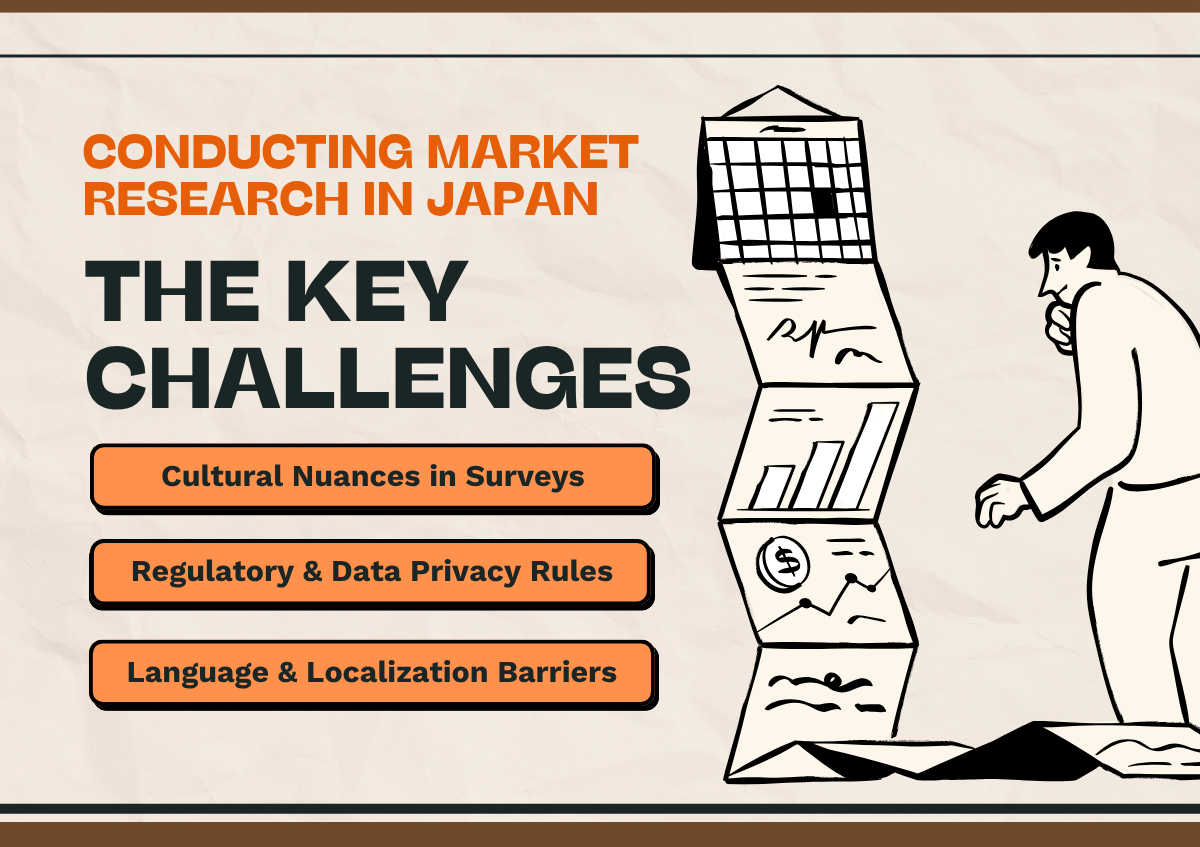
Conducting market research in Japan presents a distinct set of challenges that go beyond language translation or data collection. Success requires a deep understanding of cultural norms, regulatory frameworks, and consumer behavior that differ significantly from Western markets. Below are the most critical areas to consider.
Cultural Nuances in Surveys
Japanese consumers often communicate in a way that prioritizes harmony and avoids confrontation. This indirect style of communication can create challenges in surveys, focus groups, and interviews:
- Tendency toward neutral responses: Respondents may choose middle or “safe” options rather than strongly agreeing or disagreeing, even when they have clear preferences. This stems from a cultural aversion to appearing overly assertive or disruptive.
- Social desirability bias: Participants may provide answers they believe are socially acceptable, rather than their genuine opinions, especially on sensitive topics such as health, income, or personal habits.
- Group dynamics: In focus groups, hierarchy and age differences can affect responses. Younger participants may defer to older ones, and participants may avoid contradicting each other to maintain group harmony.
For researchers, this means standard Western survey formats often fail to capture true sentiment. Questions must be carefully localized to allow indirect yet insightful responses. For example, instead of asking “Would you switch from Brand X to Brand Y?” it is often more effective to frame questions around perceptions of product quality, trustworthiness, or subtle preferences. Moderators fluent in cultural nuances can also help probe beneath surface-level answers.
Regulatory & Data Privacy Rules
Japan enforces strict standards for consumer data collection and privacy, most notably through the Act on the Protection of Personal Information (APPI). Compared to markets like the US, where data is often collected and shared with relative ease, Japan requires additional layers of consent and transparency:
- Informed consent is mandatory: Researchers must clearly explain how data will be used, stored, and shared. Consent cannot be buried in fine print; it must be explicit and accessible.
- Restrictions on cross-border data transfer: Companies handling personal information must ensure adequate protection when transferring data outside of Japan.
- Advertising and claims oversight: Research results used in promotional campaigns must comply with consumer protection laws. Overstating findings or making unsubstantiated claims can quickly damage credibility and invite legal scrutiny.
Navigating these rules demands strict legal compliance at every step, but it also provides an opportunity: adhering to the regulations builds consumer trust. In a culture where reliability and honesty are paramount, demonstrating a commitment to data integrity can enhance a foreign brand’s reputation.
Language & Localization Barriers
While translation tools have improved, accurate research in Japan requires far more than word-for-word conversion. Japanese is layered with honorifics, context-driven meaning, and cultural subtleties that can completely alter how a question is perceived:
- Politeness and tone: A poorly phrased question may sound rude, leading respondents to disengage. Conversely, overly polite wording can soften the question to the point where answers lose precision.
- Context sensitivity: Many Japanese words and phrases carry meanings that shift depending on the setting. Without cultural context, translations risk being misunderstood.
- Metaphors and local references: Effective survey questions often rely on examples or analogies to illustrate key points. In Japan, these must be localized—references to US pop culture or idioms may confuse or alienate respondents.
Localization should extend beyond surveys into the entire research design. For example, online surveys may need to be mobile-first, as many Japanese consumers engage with them via smartphones. Recruitment messaging must be adapted to resonate with Japanese respondents, and incentives should align with local expectations (e.g., point-based systems through Rakuten or LINE).
Actionable Checklist for Foreign Companies
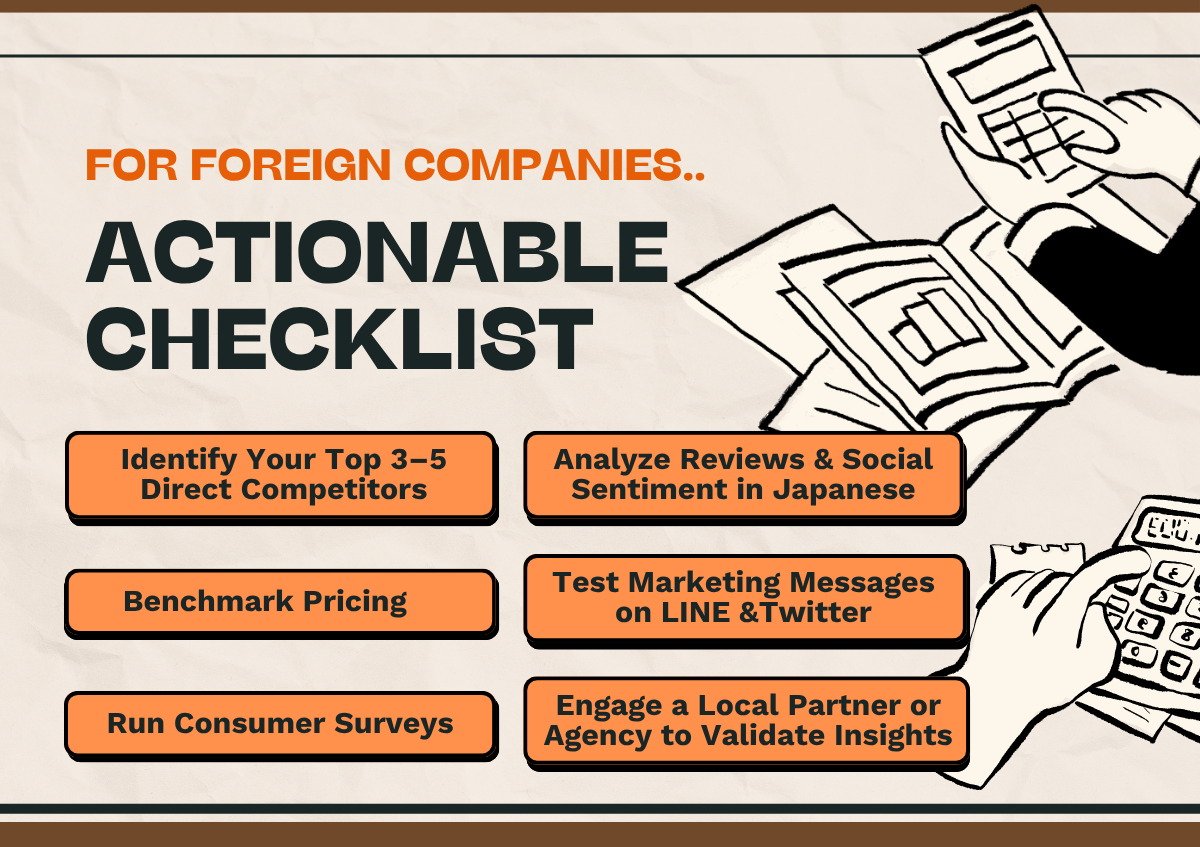
Conducting market research in Japan requires moving from broad insights to specific, structured actions. While many of the steps may look familiar to businesses operating in the US or Europe, the Japanese context adds unique challenges and opportunities. The following checklist outlines practical actions foreign companies should take, along with comparisons to how similar steps are typically executed in other markets.
Identify Your Top 3–5 Direct Competitors
In Japan, almost every product category already has strong domestic players with loyal consumer bases. Narrowing your competitor set to three to five direct rivals helps you focus on the companies that matter most.
- Japan vs. US: In the US, new entrants often scan a broad range of competitors because consumer switching is standard and disruption can come from unexpected brands. In Japan, consumer loyalty is stronger, so it is essential to study the exact brands your target audience already trusts and buys.
- Action: Utilize category-specific platforms, such as Rakuten Ichiba and Amazon Japan, to identify products that consistently rank at the top of search results. These are the brands you must directly benchmark.
Benchmark Pricing
Japanese consumers are detail-oriented shoppers who carefully compare prices across multiple channels before making a purchase. Platforms like Kakaku.com serve as default resources for consumers researching electronics, appliances, and even cosmetics.
- Japan vs. US: In the US, brands frequently test price elasticity through discounts, coupons, and promotional campaigns. Consumers expect fluctuating prices and often wait for deals. In Japan, however, pricing stability communicates trustworthiness. Constant discounts can suggest low quality or desperation.
- Action: Map your product’s price point against the top three competitors on Kakaku and Amazon Japan. Determine whether you will position as premium, parity, or value. Ensure that your pricing communicates quality and long-term reliability, not just short-term savings.
Run Consumer Surveys
Surveys are a cornerstone of market validation, but in Japan, it is essential to utilize channels that consumers trust and engage with regularly. LINE Research and Rakuten Insight are powerful because they integrate with everyday consumer platforms.
- Japan vs. US: In the US, platforms like SurveyMonkey and Qualtrics dominate because consumers are accustomed to participating via email or the web. In Japan, participation is incentivized through point systems within trusted ecosystems, such as LINE and Rakuten.
- Action: Conduct a targeted survey with questions tailored to Japanese communication styles. For example, instead of asking “Would you switch brands?” frame it as “What qualities make you continue purchasing from the same brand?” This aligns better with consumer psychology and yields more accurate insights.
Analyze Reviews and Social Sentiment in Japanese
Consumer reviews and online discussions are critical for understanding loyalty and dissatisfaction. Japanese consumers often provide detailed feedback, focusing on subtle aspects of products such as packaging, durability, or after-sales service.
- Japan vs. US: American reviews are often brief and polarized (very positive or very negative). In Japan, reviews tend to be more balanced and nuanced, highlighting small strengths and weaknesses. This makes them especially useful for identifying opportunities for improvement.
- Action: Study reviews on Rakuten, Yahoo! Japan Shopping, and Kakaku. Supplement this with social listening on Twitter Japan and LINE Open Chat, which capture real-time consumer conversations. Look for recurring themes such as packaging convenience or service quality—factors that strongly influence Japanese buying decisions.
Test Marketing Messages on LINE and Twitter
Before committing significant budget to advertising, test your messaging on the channels that matter most in Japan. LINE and Twitter are dominant platforms where consumer interaction is both frequent and authentic.
- Japan vs. US: In the US, Instagram and TikTok are often the first channels for campaign testing because of their high engagement with younger demographics. In Japan, LINE’s ubiquity and Twitter’s popularity make them the actual testing grounds. Email marketing, which is effective in the US, plays a significantly smaller role in Japan.
- Action: Run small-scale campaigns on LINE’s official account system and Twitter ads to see which messaging resonates. Track not just engagement but also how consumers discuss the campaign afterward in comments or chats.
Engage a Local Partner or Agency to Validate Insights
Even with the right tools, foreign companies often misinterpret cultural signals. A local partner or research agency, such as IGNITE, provides the contextual expertise to validate findings and prevent costly mistakes.
- Japan vs. US: In the US, many companies rely on in-house analytics teams to interpret survey and competitor data. In Japan, cultural nuances and regulatory rules make local expertise almost indispensable.
- Action: Partner with a Japanese market research firm, digital agency, or distributor who understands consumer psychology and industry norms. This not only validates insights but also builds trust with local stakeholders.
Conclusion: The Bottom Line on Market Research in Japan
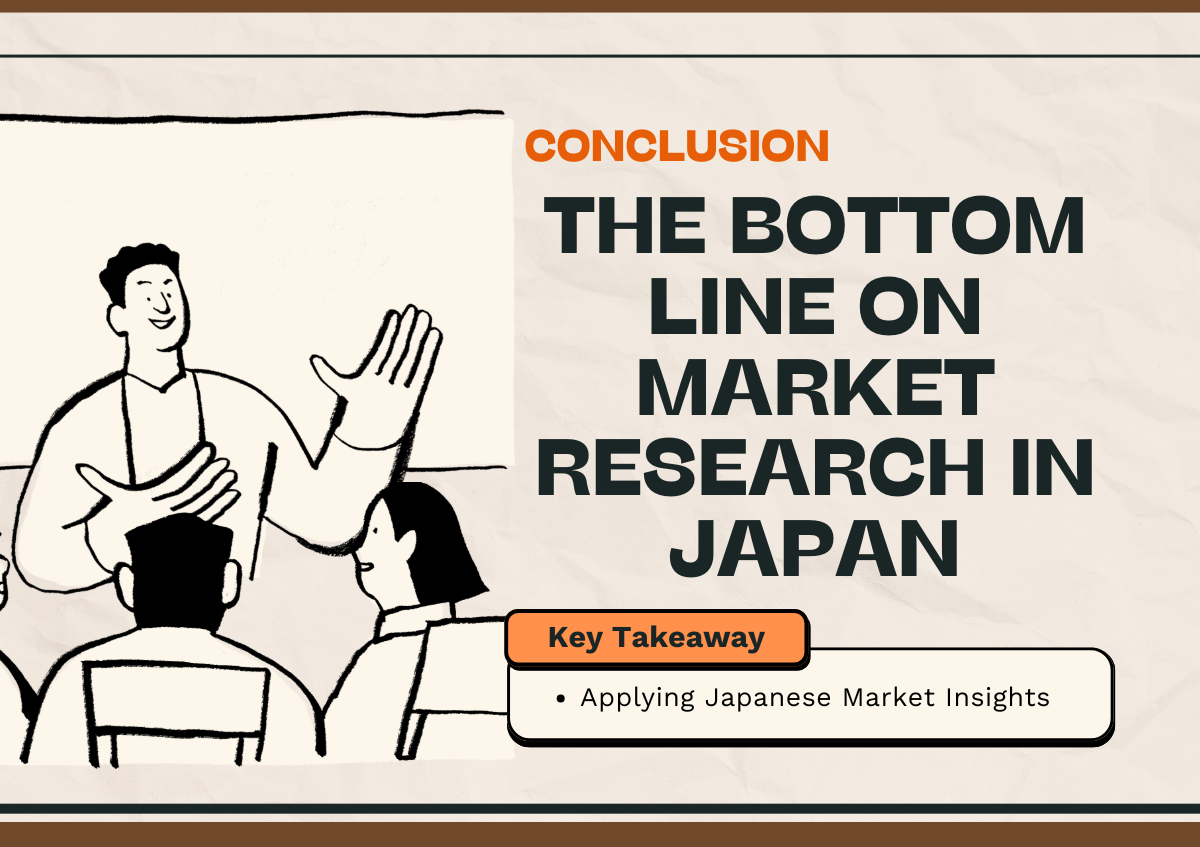
Market research in Japan goes far beyond spreadsheets and raw numbers; it is about interpreting competitive landscapes, pricing realities, and the psychology of local consumers. By validating products–market fit before launch, companies save money, reduce unnecessary risks, and earn customer trust more quickly. For businesses serious about succeeding in Japan, careful market research is not a hurdle to overcome; it’s the gateway to long-term growth and sustainable success.
Key Takeaways: Applying Japanese Market Insights
Before launching in Japan, companies need more than ambition — they need insight. Here are the essential lessons to turn research into real-world results.
- Competitive analysis and benchmarking are critical to understanding the market landscape.
- Pricing, customer sentiment, and buyer behavior in Japan often differ significantly from those in other regions.
- A data-driven approach to market entry increases the likelihood of sustainable growth.
- Companies that invest in proper localization stand the best chance of long-term success in Japan.
Partner with IGNITE for Specialized Support

Chez IGNITE, notre spécialité est d'aider les entreprises étrangères à réussir au Japon en éliminant les conjectures et en surmontant les barrières culturelles. En tant qu'équipe multilingue de spécialistes du marketing japonais et international basée à Osaka, nous agissons en tant que partenaire local dévoué, et pas seulement en tant que fournisseur.
Que vous ayez besoin de traduction et de localisation, de publicité numérique, de référencement, de conception Web ou de planification commerciale basée sur les données, nos campagnes axées sur les résultats sont conçues pour vous aider à pénétrer, à vous adapter et à évoluer sur le marché japonais. Nous commençons par des recherches approfondies, localisons vos messages avec précision et adaptons vos campagnes pour une croissance mesurable.
Si vous êtes prêt à vous développer au Japon en toute confiance, laissez IGNITE être votre catalyseur.
Contactez-nous dès aujourd'hui pour commencer à élaborer votre stratégie pour le Japon.



